What's Happening?
Gold prices have experienced an increase, nearing $4,000 per ounce, driven by a weaker dollar and renewed safe-haven demand. This rise is attributed to concerns over a potential prolonged U.S. government
shutdown and legal uncertainties surrounding President Trump's tariffs. Spot gold increased by 0.4% to $3,998.65 per ounce, while U.S. gold futures for December delivery rose by 0.3% to $4,005.40 per ounce. The dollar's decline by 0.3% after reaching a four-month high has made gold more affordable for holders of other currencies. Additionally, U.S. 10-year Treasury yields have decreased by 1.3%. The market is also reacting to the U.S. Federal Reserve's recent interest rate cuts, with expectations of another cut in December.
Why It's Important?
The rise in gold prices highlights the market's response to economic and political uncertainties, particularly the U.S. government shutdown and tariff issues. Gold is traditionally seen as a safe-haven asset during times of instability, and its increased demand reflects investor concerns. The situation also underscores the impact of U.S. monetary policy on commodity markets, as lower interest rates tend to benefit non-yielding assets like gold. The potential for further Federal Reserve rate cuts could continue to influence gold prices, affecting investors and financial markets globally.
What's Next?
Market participants are closely watching for further developments regarding the U.S. government shutdown and the legal challenges to President Trump's tariffs. Additionally, upcoming speeches by Federal Reserve officials may provide insights into future monetary policy decisions, which could further impact gold prices. Investors are also monitoring central bank activities, as continued buying could support gold prices. The market anticipates a year-end target for gold prices in the range of $4,300 to $4,400 per ounce, depending on these unfolding events.
Beyond the Headlines
The current situation with gold prices reflects broader economic and geopolitical tensions. The legal scrutiny of tariffs and the government shutdown are part of larger debates about trade policies and fiscal governance in the U.S. These issues could have long-term implications for international trade relations and economic stability. Additionally, the role of central banks in influencing commodity markets through their purchasing strategies highlights the interconnectedness of global financial systems.












